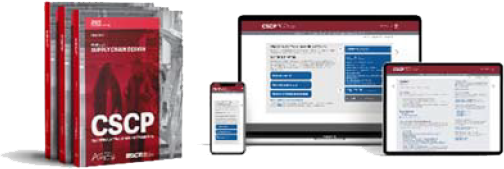
The APICS CSCP Learning System is a comprehensive professional development and exam preparation program. It consists of eight reading modules and web-based study tools that reflect the entire APICS CSCP Exam Content Manual (ECM) and provide a broad view of global end-to-end supply chain management. Each module will further empower you with an understanding of best practices, techniques and technologies necessary to maximize your organization’s efficiency and impact the bottom line.
MODULE CONTENT
Module 1: Supply Chains, Demand Management, and Forecasting
- Visualizing the supply chain entities, structures, and flows used to procure and deliver goods and services
- Differentiating vertical versus horizontal integration and different levels of supply chain maturity
- Using planning, communicating, influencing, and prioritizing steps in demand management, including market research and demand forecasting
- Assessing portfolios and products using product portfolio management, the 4Ps of marketing, and product life-cycle management (PLM)
- Using sales and operations planning (S&OP) to align supply with demand
Module 2: Global Supply Chain Networks
- Designing the supply chain and configuring the supply chain network
- Balancing efficiency with responsiveness while being resilient
- Optimizing technology by matching requirements to various supply chain technologies and interfaces
- Forming cross-functional and cross-organizational supply chain design teams
- Safeguarding and maintaining cybersecurity, data privacy, and supply chain master data
- Improving the supply chain by measuring and analyzing performance with supply chain metrics focused on customers, financial reports, operational practices, and customer service
- Becoming familiar with accounting and financial reporting information and strategic analysis tools
Module 3: Sourcing Products and Services
- Following a sourcing process to capture changes, such as for new products
- Managing supply based on total cost of ownership and make-versus-buy analysis
- Developing a category strategy and sourcing categories
- Doing spend and portfolio analyses to right-size the supplier base
- Developing supply plans based on buyer-supplier relationships
- Influencing product designs to promote collaboration and requirements inclusiveness
- Negotiating effective supply contracts/purchase orders and selecting proper payment terms
Module 4: Internal Operations and Inventory
- Leveraging manufacturing planning and control including master planning, master scheduling, material requirements planning, distribution requirements planning, and various levels of capacity checks
- Managing, planning, and controlling inventory to keep it at proper levels and replenish it efficiently
- Understanding the effects of inventory on financial statements and inventory-related cost categories
- Using quality and continuous improvement techniques and principles, including lean and just-in-time
Module 5: Forward and Reverse Logistics
- Determining strategies for logistics, warehouse management, and transportation management
- Complying with international standards and considerations for import/export, tax/tariff, and labor laws
- Managing reverse logistics and waste
Module 6: Supply Chain Relationships
- Segmenting customers, suppliers, and other partners
- Using supplier relationship management (SRM) and customer relationship management (CRM) to develop, measure, and maintain relationships
- Understanding the communication process and dimensions
Module 7: Supply Chain Risk
- Identifying, assessing, classifying, and responding to supply chain risks in a cost-effective manner
- Learning about common supply chain risks and how to make preventive and contingent action plans
Module 8: Optimization, Sustainability, and Technology
- Considering inputs and objectives of organizational strategy and supply chain management strategy
- Recognizing and resolving strategic misalignments and gaps
- Building sustainable best practices and ensuring corporate social responsibility compliance
- Embracing sustainability principles, standards, and reporting methods, including the UN Global Compact and GRI sustainability reporting standards
- Assessing technology needs and learning about emerging technologies
- Implementing changes using project management and change management
